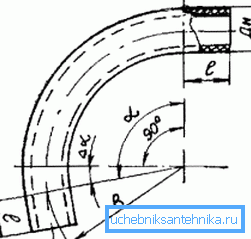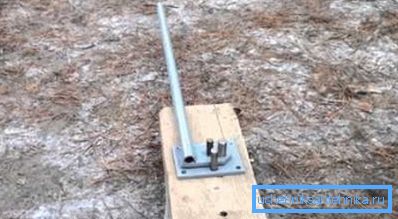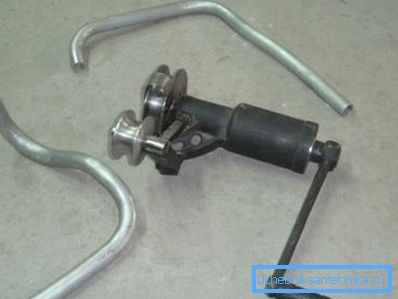Pipe bending: how to bend a part at home
Steel and plastic pipes are used not only for arranging water supply, sewage and heating systems. They make many other useful designs. But in fact, and in another case, one of the most complex processes is the bending of pipes in a cold state. Let us consider its description in more detail.

Pipe bending parameters
Like most other complex technological processes, bending of pipes is regulated by strict technological norms.
You need to follow a lot of nuances:
- when bending the part should not flatten or tear;
- during bending you need to ensure that the material is not wrinkled corrugated;
- Be sure to observe the minimum bend radius, which depends on the pipe material, its wall thickness and diameter.
The instruction, fixed by GOST 3262-92, provides for a different bending radius for round metal pipes. The thicker the part, the larger the minimum bend radius will be.

When bending with your hands, you must comply with the following requirements:
- for pipes with a diameter of up to 20 mm, the minimum bending radius is 3 outer diameters;
- for large parts - 4.
It should be noted that the hot bending allows halving these values, but requires the use of specialized equipment. This happens because the heating process greatly increases the plasticity of metal pipes.
Note! Thick-walled products designed for the arrangement of water pipes, it is very difficult to bend. Therefore, in order to avoid problems, it is not recommended to use the minimum bending radius. If necessary, it is better to use fittings.
It is even more difficult to bend square tubes (profiled). For this purpose, special devices are used, equipped with a mandrel - a flexible steel part that fits inside the part when bent and prevents the formation of kinks or corrugations.
Professionals use special CNC mandrel benders (controlled by a computerized system), with the help of which the smoothest roundness is obtained.

Bending aluminum pipe, as well as products from copper and brass, is less labor intensive, since these metals are very ductile. However, the physics of the process does not change.
When it bends, the inner surface of the turn becomes thicker and deformed, and the outer one becomes thinner. This affects the strength and degrades the technical characteristics of the parts. It does not matter if cold or hot technology was used.
Independent pipe bending
Steel parts
For the bending of metal products used manual pipe benders, which have several different nozzles for processing parts of different sizes and from different materials. Most often they use a hydraulic jack, which allows to process a thick-walled pipe.
If you need to make one or two bend, it is advisable to contact the plumbers of the housing department. They usually have a similar device, and the price for services will be small.
In extreme cases, you can make a bend with the help of available tools, but it will require a large investment of time and effort.
For work you will need:
- table or carpentry workbench;
- river sand (its amount depends on the diameter of the pipe);
- a cylindrical metal billet, the radius of which is as close as possible to the size of the bend of the pipe;
- two stoppers for sealing the pipe ends;
- gas torch (blowtorch).

The work is performed in the following sequence:
- Sand must be cleaned of impurities and calcined with a burner until it stops smoking when heated.
- The cylindrical workpiece is fixed in the joiner's vise, which, in turn, must be attached to the workbench, otherwise the whole structure will turn.
- In order for the pipe to retain its internal cross section, it must be filled with calcined river sand. So that it does not get enough sleep, the edges of the pipe are blocked with traffic jams.
Tip! Sand should be poured as tightly as possible. Seal it with a wooden stick or by tapping on the pipe.
- Then one end of the workpiece is inserted between the stop and the used mandrel, and the other is bent in the right direction. If the pipe is too short, another part can be put on its end, which will serve as a lever. The angle should be made 2-3 degrees more, since the pipe will partially recover its shape after the cessation of exposure.
- If you need a strong bend, gas burner will help. With its help, you need to heat the part in the bend to cherry color, and then bend the pipe. To get hot air out of the product, it is necessary to drill small holes in traffic jams.
- At the end of the work, plugs are removed or cut off, and sand is poured out.

The finished bent part must be checked for defects:
- inspect the place of the fold and make sure there are no cracks, stretch marks, metal damage and corrugations;
- sweep the place of the bend from the scale and scale;
- if necessary, cut threads of the required size at the ends of the blank.
Pipes made of soft metals
The processing of pipes made of copper, brass or aluminum is almost the same as in the previous section. Such products can be bent without heating, but at the same time it is recommended to fill the internal space of the part with molten rosin.
When you need to bend the workpiece to the minimum possible diameter, it is recommended to still warm up the material. It will be easier to work, but if defects appear, it will be more difficult to correct them - reheating will be needed.
Note! Instead of sand or rosin to fill the inner space, you can use a spring of suitable diameter. They are sold in specialized stores.

If you often oppose various pipes, it is advisable not to stint and get yourself a special pipe bender for bending pipes, which allows you to easily and quickly process a large number of pieces.
Conclusion
The most qualitative, of course, is the mandrel bending of pipes, which is carried out by machine-controlled machines. However, at home, you can bend the detail of quality, if you carefully follow the above recommendations. You can learn more about this in the video in this article.